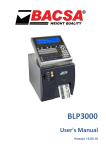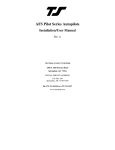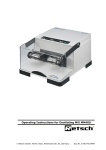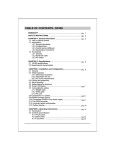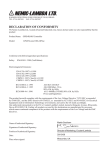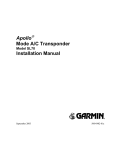Download Quick Reference Guide to CAP FM Radio Used in CAWG Aircraft
Transcript
Quick Reference Guide to CAP FM Radio Used in CAWG Aircraft Turning on the Radio Desired Action Procedure Turn on radio Coordinate with pilot so you are using COM 3 thru the audio panel Make sure EDIT switch is centered Turn MAIN (MN ) volume knob-clockwise Turn volume MN Knob to middle (approx) Turn GUARD (GD) volume knob to middle (approx) Clear Help screen Toggle BRIGHTNESS switch once in either direction Adjust screen brightness Toggle BRIGHTNESS switch either direction as desired Set display Move DSIP switch to left (ID) position Select channel Move CHANNEL switch right or left (+ or -) to desired channel according to chart for repeaters Set scan switch Move SCAN switch to middle position Set Guard frequency Move GD1/GD2 switch to the GD1 position Adjust volume controls Turn MN and GD volume knobs to comfortable settings Adjust Squelch Press white SQ button: IN to hear weak signals, OUT for normal signals Transmitting and Receiving Receiving Move Move SCAN switch to NORM as stated above. You are listening to 148.150 thru the repeater selected (The orange light to the right of the MN knob will come on when you are receiving thru the repeater) You are also listening to 148.150 simplex thru Guard 1 (The orange light to the right of the GD knob will come on when you are receiving thru the simplex receiver) Transmit thru repeater Key Push to Talk (PTT) switch (usually on your yoke) Transmit on simplex Move the SCAN switch down to GD TX (display screen should say channel 01 simplex) Key PTT switch (usually on your yoke) NOTE: The EDIT switch should always be in the center position. 1 Mar 2001 by Capt. Woody McCauley Quick Reference Guide for Audio Control Panel Installed in the Standard CAWG CAP AIRCRAFT (PMA 7000M-S) What you want to do Turn on the audio panel Adjust the volume Set Marker Mode Set the crew mode Select the transmit function Turn on desired radios and set frequencies Required action Pull the large knob on the left labeled VOLUME Rotate the large knob on the left labeled VOLUME This adjusts ICS volume only -radio volume is adjusted on each radio Move the upper-left silver switch to the LOW (middle) position Move the lower-Ieft silver switch to the ALL (middle) position Rotate the large knob on the right to the desired transmitter setting (See chart below) See operating instructions with each radio Transmitter Combinations (designed for some common situations) TX Selector Pilot COM 1 Com 1 Com 1 (a) Both pilot and Observer transmit & listen on Com 1 (Pilot TX priority) Both are able to listen and transmit on same FAA radio (tower, ATC etc.) COM 2 Com 2 Com 2 (a) Both pilot and Observer transmit & listen on Com 2 (Pilot TX priority) Both are able to listen and transmit on & same FAA radio (tower, ATC etc.) COM 3 Com 3 Com 3 (a) Both Pilot and Observer transmit & listen on Com 3 (CVAP Radio) Working in remote location where no other FAA frequencies are needed COM 1/2 Com 1 Com 2 (b) Pilot transmit & listen on Com 1 Observer transmit & listen on Com 2 Pilot with ATC and Observer with air-toair or air-to-ground frequency such as 1 129.45 COM 1/3 Com 1 Com 3 (b, c) Pilot transmit & listen on Com1 Observer transmit & listen on Com 3 Pilot with ATC and Observer using CAP radio. Cannot hear each others communications (ICS ok) COM 2/3 Com 2 Com 3 CAP (b, c) Pilot transmit & listen on Com2 Observer transmit & listen on Com 3 Pilot with A TC and Observer using radio. Cannot hear each others communications (ICS ok) Observer Notes Action Common Situation Notes: (a) Pushing another COM or NAV button permits listening to that radio but no transmitting (guarding). (b) When COM 3 button is pushed in a COM 3 split mode, pilot will hear COM 3 but no transmitting (guarding). (c) Pushing ICS button in a split mode, permits ICS function between Pilot & Observer. See user manual for more complete information. Pilot should always approve any change to audio panel setting. 10 Apr 2001 by Capt. Woody McCauley GPS Training: -GX55 Downloadable Simulator You can now practice using the Apollo GX55 GPS that is standard in CA WG aircraft. The simulator program (basic version) is free and can be downloaded to your PC from the Internet. It installs easily and there are plenty of helps available to be viewed or printed. The installed and expanded program takes about 4.3 mega bytes of hard drive space. It runs on my Windows 98 SE platform but I believe it will run on any Windows 95 or higher operating system. To Download the simulator: Use your Internet browser program to locate the www site called: upsat.com. Scroll down and click on GX Simulator Basic w/ Americas database. Save as GX Simulator-Basic-Americas. Follow the instructions as the program is loaded and installed on your computer. Suggestion: Use appropriate Folder/File names when prompted. I used the suggested defaults and had no problems. To Run the GX55 Simulator: From your desktop, press the START button. Point to Programs. Point to II Morrow GX Simulator Click on GX Simulator (Basic) The first time thru, I suggest clicking on the Help button and printing the Simulator Procedure Summary. Click on the ON/OFF switch and the program will begin. Click the ON/OFF button to stop the program. Other items suggested to print for reference: Simulator controls. Simulator menu items. Creating a flight plan. Activating a flight plan. Any other helps needed. Other suggestions: If you are flying a long flight plan, increase you airspeed (up to 990 kts.) to get more rapid results. This is designed for GPS training not as a flight simulator. Note that the Large and small knobs may be turned to the left with the left mouse button and turned to the right with the right mouse button. Submitted by Capt. Woody McCauley GPS (GX55) SUPPLEMETAL QUICK REFERENCE S.A.R. MAP FEATURE The steps in setting up the SARMAP feature include: (See user manual for detail description -see page references below) A. GPS Map Setup Page -Turn Route Line On (pg. 22) B. SAR Map Setup Page (pg. 76-80) C. Select a Search Pattern (pg. 82-89) D. Activate the Search (pg. 89) E. Select Grid Line Display (pg. 77-78) F. Mark a Position (pg.90) A. GPS Map Setup Page -Turn Route Line On 1. Press MAP and then turn LARGE knob CCW 1 click to reach GPS Map Setup Page. 2. Press SEL. Route Line option will flash. 3. Turn the SMALL knob value to YES. Press ENTER to save selection. B. SAR Map Setup Page 1. From the GPS MAP Setup Page (see A. above). Turn SMALL knob CCW 2 clicks to SAR Man Setup Page. 2. Press SEL. SAR Map option flashes. Turn SMALL knob to set the SAR Map value to ON. 3. Turn LARGE knob CW I click. Grid Type option flashes. Turn SMALL knob to choose a Grid Type value of US or Basic. The US Grid Type is based on aeronautical chart grids. The Basic Grid Position is based on Lat/Lon positions. 4a. For U.S. Grid Type. Turn LARGE knob CW 1 click. Position option flashes. Turn SMALL knob right or left to select desired Sectional Aero Chart. Press ENTER to save selections. Turn LARGE knob CCW I click to return to SAR MAP. 4b. For Basic Grid Type. Turn SMALL knob CCW 1 click to reach the SAR Position page. Press SEL. The Latitude value will flash. Select the Latitude value nearest to your intended search area with the SMALL knob. Turn the LARGE knob to the Longitude value. Select the Longitude value nearest to your search area with the SMALL knob. Press ENTER to save selections. Turn LARGE knob CCW 1 click to return to SAR MAP. C. Select a Search Pattern 1. From SAR Map. (If not in SAR Map. Press MAP, turn LARGE knob CW 2 clicks) 2. Pat the PAT smart key. Search pattern type will flash. 3. Turn the SMALL knob R/L to select the desired pattern type. Press ENTER to select pattern type and begin selecting options. Creeping Line (It is based on a Waypoint, not a grid.) 1. Press SEL, INS? flashes. Press ENTER. Wypt. type flashes. Select the waypoint type and ident. The same as for the DIRECT TO function. Press ENTER to save Wypt. start point. Spacing flashes. 2. Turn SMALL knob R/L to desired value. Turn LARGE knob CW 1 click. Direction flashes. 3. Turn SMALL and LARGE knobs to desired direction. Press ENTER to save selection. 4. Turn SMALL knob CW 1 click. Press SEL, “5.0” flashes. Turn SMALL knob R/L to desired value. 5. Turn LARGE knob CW 1 click. “Right” flashes. Turn SMALL knob to desired value. 6. Press ENTER to save selections. 7. Press ENTER to activate search pattern and return to SAR Map. Note: CW = Clockwise, CCW = Counter Clockwise 25 Aug. 2001, by Capt. Woody McCauley Page 1 of 2 GPS (GX55) SUPPLEMETAL QUICK REFERENCE S.A.R. MAP FEATURE (cont.) Search Patterns (continued) Expanding Square (Starts on a user selected waypoint. This can be the nearest airport, intersection. navaid or user waypoint.) 1. Press SEL. INS? flashes. Press ENTER Wypt. type flashes. Select the waypoint type and ident. The same as for the DIRECT TO function. Press ENTER to save Wypt. start point. Spacing flashes. 2. Turn SMALL knob R/L to desired value. Turn LARGE knob CW I click. Direction flashes. 3. Turn SMALL & LARGE knobs to desired direction. 4. Press ENTER to save selections. 5. Press ENTER to activate search pattern and return to SAR MAP. Parallel Line (Creates a search pattern based on an established grid.) 1. Press SEL. INS? flashes. Press ENTER. Grid flashes. Turn LARGE and SMALL knobs to select the desired grid. Turn LARGE knob I more click past last grid position. Spacing flashes. 2. Turn SMALL knob R/L to desired spacing. Turn LARGE knob CW I click. Direction flashes. 3. Turn SMALL knob R/L to enter desired direction (n/s or e/w). 4. Press ENTER to save selections. 5. Press ENTER to activate search pattern and return to SAR MAP. D. Activate/Deactivate Search Pattern 1. To activate a search pattern, Press ENTER, this returns you to SAR Map. The annunciator above the PAT smart key with be highlighted. 2. To deactivate the search pattern, press the PAT smart key. The annunciator above the PAT smart key will no longer be highlighted. E. Select a Grid Line Display 1. While viewing the SAR Map, press the GRD smart key. Select the appropriate grid line display by repeatedly pressing the GRD smart key. Note the selection options vary slightly for the two grid types (US or Basic). Grid detail displayed varies with range selected (10- 40 nm is usually best). G. Mark a Position (When viewing the SAR Map, you may save a User waypoint to Mark a location of interest. Pressing the MRK smart key saves the User waypoint at the present position of the aircraft.) 1. While viewing the SAR Map page, press MRK. The User waypoint creation page will appear with the current Lat/Long position. The default waypoint name will be SAROOO (the first time). Subsequent User waypoints will automatically increment to SAR001, SAR002, etc. 2. You may enter the name and position with the SMALL and LARGE knobs. 3. Press ENTER to store the displayed name and position. Note: Use SAR Map screen with Icons to fly to a saved SAR waypoint or use DIRECT TO or NRST functions to fly to the saved SAR waypoint. 25 Aug. 2001, by Capt. Woody McCauley Page 2 of 2 DF Unit Functional Checks Functional Check - No transmitter This is a quick check that can be made part of a preflight routine to assure that a previously checked unit is still working: 1. 2. 3. 4. 5. 6. 7. Select 121.5 MHz on the DF. Turn the Alarm toggle switch off (down). Turn the SENS control (outer knob) fully clockwise to maximum. Turn on power to the radio system. Turn on the DF by advancing the VOL control (inner knob). A hissing sound should be heard through the audio system and the signal strength needle will be between ¼ and ½ of the way between the center of the scale and the left-hand end. The DF needle will stay roughly centered. Now turn the SENS control counterclockwise toward minimum. This will cause a decrease in sound volume (some sound may still be heard) and a decrease in the strength meter reading. 8. Next, turn the SENS control to maximum. The DF needle should move randomly back and forth one or two needle-widths about the center in response to receiver background noise. Movement will be slow and may be difficult or impossible to see. 8. As a final check, turn the Alarm toggle switch to on (up). The Alarm light should flash for 10 to 20 seconds and then stop. The receiver noise should also cut off at the same time. The Alarm is now set and will respond to a steady ELT signal. [NOTE: This Alarm setting period occurs each time the Alarm function of the DF is turned on. It tests the Alarm circuits and reminds the pilot that the DF receiver is on.] Functional Check - with transmitter and the aircraft on the ground All features of the DF except the Alarm circuit can be checked using a signal generator or a transmitter on 121.775 MHz (e.g., a practice ELT, a portable transceiver, or another aircraft’s radio). 1. 2. 3. 4. 5. 6. 7. 8. Park the aircraft in the open, away from metal buildings. The transmitter should be at least 50 feet in front of and 1530 degrees to one side of the aircraft. WARNING: Use of high-power transmitters close to the DF antennae can damage the unit. Damage can occur from a 50-watt transmitter if it is within 12 feet of the antennae (3 feet for 5W; 4 1/2 feet for 10W; 15 feet for 80W). The ELT tester should be kept at least 50 feet away from the antennae when using to test for operability of the DF. Select 121.775 MHz on the DF. Rotate the SENS control fully counterclockwise to minimum. Set the VOL control to about the 12 o’clock position. Set the Alarm toggle switch off (down). Turn on the DF and the transmitter. If necessary, rotate the SENS control clockwise until the signal or the DF buzz is heard. The DF needle should point toward the transmitter. Move the transmitter to the other side of the aircraft and observe the DF needle, which should follow the transmitter. NOTE: On the ground it is normal for the needle to be uncertain about centering with the test transmitter directly fore or aft. The DF is OK if the needle points correctly when the transmitter is on either side of the aircraft. Move the SENS control clockwise. The strength needle will move (slowly) further to the right. Functional Check - with transmitter and the aircraft in flight Place the test transmitter as high and clear as possible in open terrain. Fly about three to five miles away at 2000 to 3000 feet AGL. Make several full circles, starting with no more than a 10° bank angle. The DF needle should crossover only twice during the turn at shallow bank. More than two crossings indicate unsatisfactory operation. Pilots and Observers should note how the DF performs at steeper bank angles for future reference. Note also where wing shadows occur, as indicated by decreases in the strength meter reading and/or audio volume during steep turns. This is a useful verification of DF indications. Determine the direction to the ELT by turning in the direction of DF needle deflection. With the needle centered, follow the DF course inbound and compare it to the visual heading to the target transmitter. The inbound course and the heading to the transmitter should agree to +/- 5°; up to +/- 15° errors is quite usable. If desired, you can note the error on a placard near the DF receiver. Finally, compare the inbound and the outbound courses using the DG (heading indicator). They should differ by 180°. Course errors of up to 30° are usually due to unsymmetrical installation of the antennas or, on the ground, to nearby reflecting objects (e.g., cars or buildings). Asymmetry usually causes both front and rear courses to be bent toward the same side of the aircraft and usually toward the source of the problem. Severe errors or one-sided needle indications are usually due to a damaged antenna-to-switchbox cable or to poor grounding at the antenna or a skin joint nearby. Poor skins joint contact may well indicate structurally significant corrosion and should be investigated by a mechanic. ELT Check List DF Method Verify or select 121.5 on the frequency switch and place the Alarm toggle switch to off (down). The DF function is not operable in the alarm mode (toggle switch up). Set the SENS to maximum and the VOL to a comfortable level. Climb to an altitude of at least 3000 to 4000 feet AGL or higher, if possible. If this fails to acquire the signal, start a methodical search (e.g., expanding square, sector or route). Continue flying until a reasonable level of signal is acquired. The DF needle should deflect to one side and the Strength needle should come on-scale. Make a 360° turn at no more than a 30° bank to ensure you get two needle centerings (approximately 180° apart) to verify the heading. When the turn is complete, center the DF needle and fly toward the ELT. Note your heading (write it down) for reference. If the ELT is heard on both 121.5 and 243.0 MHz, compare the headings. If they differ by more than 45° or if the turn produces multiple crossovers, try a new location or climb to a higher altitude to escape from the reflections. While flying toward the ELT the DF needle may wander back and forth around center at 10- to 30-second intervals. This is caused by flying through weak reflections and should be ignored. Fly the heading that keeps needle swings about equal in number, left and right. Don’t become concerned if the signal slowly fades out as you fly towards the ELT. If this happens, continue on your heading for at least six minutes. If you are still headed toward the ELT the signal should slowly build in strength in three or four minutes and be somewhat stronger than before the fade. If the signal does not reappear, return to where the signal was last heard and try a different altitude. As you get close to the ELT the signal will get stronger, and you will have to periodically adjust the SENS control to keep the signal strength needle centered (do not decrease the VOL control as this could overload the receiver). You also need to do this if the DF needle gets too sensitive. Periodically yaw the aircraft and observe the DF needle respond (left and right). A “station passage” is often seen as a rapid fluctuation in signal strength and confused DF readings. Yaw the aircraft to see if the course has reversed (needle goes in the direction of the aircraft turn). If the course has reversed, continue on your heading for a few minutes. Then turn and make several confirmation passages from different angles while continuing your visual search. Homing Method Tune the receiver to the ELT frequency and listen for the warbling tone of the ELT signal. Fly directly toward the signal. Starting with the left/right needle centered, the pilot turns the aircraft in either direction, so that the needle moves away from center. In a left turn, and the needle deflects to the right, the ELT is in front. Turn back to the right and center the needle to proceed to the ELT. If the needle swings to the extreme left, then the ELT is behind you. Continue the left turn until the needle returns to the center. You are now heading toward the ELT. Fly toward the ELT, maintaining the needle in the center of the indicator. If the needle starts to drift left of center, steer slightly left to bring the needle back to the center. If it starts to drift right, turn slightly back to the right. Over the ELT, the left/right needle will indicate a strong crossover pattern. The needle will make a distinct left-toright or right-to-left movement and then return to the center. This crossover movement is not a mere fluctuation; the needle swings fully, from one side of the indicator to the other and then returns to the center. Note: During homing you may encounter situations where the needle suddenly drifts to one side then returns to center. If the heading has been steady, and the needle previously centered, such a fluctuation may have been caused by a signal from a second transmitter or signal reflections from objects or high terrain.












